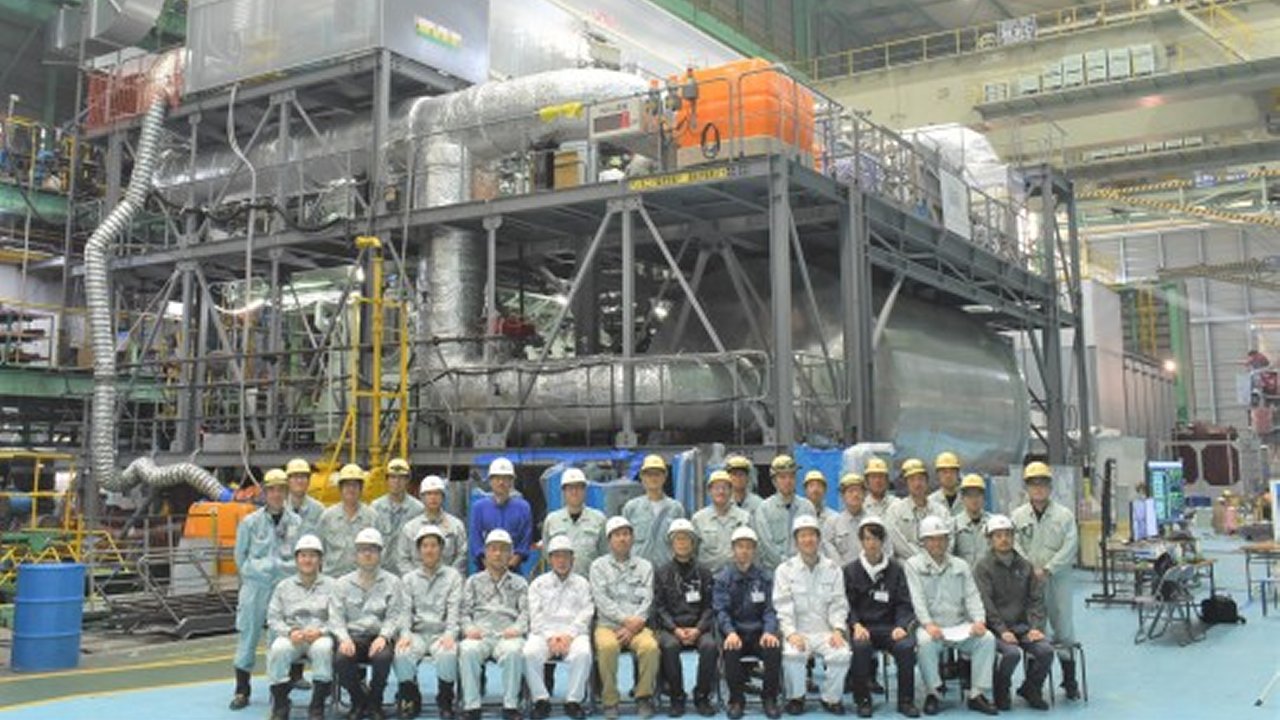
 |
Japan Engine Corporation (J-ENG) claims to have completed the world's first commercial ammonia-fueled engine, marking a potential advance in maritime decarbonization technology.
The company said its 7UEC50LSJA-HPSCR engine — featuring a 50 cm bore and seven cylinders with high-pressure selective catalytic reduction — completed official test runs on August 30 at J-ENG's factory. The testing was conducted under supervision from Nippon Yusen Kaisha (NYK Line), Nihon Shipyard Co., Japan Marine United Corporation (JMU) and classification society Nippon Kaiji Kyokai (ClassNK).
According to J-ENG, the dual-fuel engine underwent performance verification tests in both ammonia fuel and heavy fuel oil operation modes, with ClassNK certifying its environmental performance and safety features.
The engine is scheduled for shipment in October and installation on an ammonia-fueled medium gas carrier under construction at JMU Ariake Shipyard, with the vessel expected to enter service in 2026.
J-ENG said it conducted approximately 1,000 hours of testing on a single-cylinder ammonia-fuel test engine at Mitsubishi Heavy Industries Research & Development Center in Nagasaki between May 2023 and September 2024. The company began testing the full-scale commercial engine on ammonia fuel in April 2025, accumulating 700 hours of testing over five months.
The development forms part of the "Next-Generation Ship Development" program under the Green Innovation Fund Project, administered by Japan's New Energy and Industrial Technology Development Organization (NEDO).
Trial data indicates that at 100% load and 95% ammonia co-firing rate, nitrous oxide emissions were approximately 3 ppm, representing what J-ENG claims is a reduction of over 90% in greenhouse gas emissions compared to conventional engines. The company said nitrogen oxide emissions were approximately half those of heavy oil engines, with unburned ammonia emissions virtually zero after selective catalytic reduction treatment.
J-ENG said thermal efficiency in ammonia fuel operation mode was equivalent to or higher than heavy oil operation mode.
The company is concurrently developing a 60 cm bore ammonia-fueled engine and is constructing a new factory with government support to expand production capacity. The facility is scheduled to commence operations in fiscal year 2028, utilizing funding from GX Economic Transition Bonds through a joint project by Japan's Ministry of the Environment and Ministry of Land, Infrastructure, Transport and Tourism.
J-ENG said it aims to contribute to greenhouse gas emission reductions in the shipping industry and support Japan's carbon neutrality target by 2050 through early market introduction of ammonia-fueled engines.

|
BP to sell 65% stake in Castrol to Stonepeak for $10bn enterprise value
Deal brings BP's divestment programme to $11bn, with proceeds earmarked for debt reduction. |
|
|
|
||

|
RINA approves design for Clippership's 24-metre autonomous wind-powered cargo vessel
Classification society to supervise construction of zero-emission ship featuring twin rigid wings for transatlantic operations. |
|
|
|
||

|
Bureau Veritas classes first methanol dual-fuel boxship as CMA CGM takes delivery
The 15,000-teu CMA CGM Antigone was built by CSSC Jiangnan Shipyard in China. |
|
|
|
||

|
Samsung Heavy Industries' floating nuclear plant design wins ABS approval
Concept features twin KAERI small modular reactors and a compartmentalised layout to support offshore nuclear power generation. |
|
|
|
||

|
Dan-Bunkering Europe appoints Claire-Celine Bausager Jørgensen as senior fuel supplier
Jørgensen returns to bunker trading after several years in the company's HR department. |
|
|
|
||

|
DHL and CMA CGM partner on 8,990-tonne biofuel purchase for ocean freight decarbonisation
Logistics and shipping firms to use UCOME biofuel, targeting 25,000-tonne CO2e reduction. |
|
|
|
||

|
Glencore to acquire majority stake in Dutch marine fuel supplier FincoEnergies
Transaction expected to complete in Q2 2026, subject to EU anti-trust approval. |
|
|
|
||

|
CMA CGM names 15,000-teu methanol-fuelled containership CMA CGM Eugenie
Vessel to operate on Phoenician Express service linking Asia, Middle East, and Mediterranean. |
|
|
|
||

|
Island Oil appoints Christian Larsen as senior trader in Denmark expansion
Marine fuel supplier establishes operations in Denmark as part of expansion strategy. |
|
|
|
||

|
HIF Global signs Uruguay agreement to advance US$5.3bn e-fuels facility in Paysandú
Memorandum sets roadmap for final investment decision on plant targeting 880,000 tonnes annual production. |
|
|
|
||
| Yara Clean Ammonia secures dual-fuel vessels in Navigator Amon deal [News & Insights] |
| Itochu orders 5,000 cbm ammonia bunker vessel [News & Insights] |
| MAN Energy Solutions achieves 100% load milestone for ammonia engine [News & Insights] |